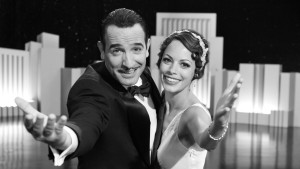

During the late 1920s, Hollywood’s new “talkies” didn’t just take over the film industry — they enabled the United States to ever-so-subtly conquer the world
Come Sunday night amidst all the glitz and glam at the Dolby Theatre in Hollywood, the 88th Annual Academy Awards is sure to produce its share of memorable moments.
Especially if Leonardo DiCaprio finally wins an elusive Oscar — or doesn’t.
When it comes the most monumental moments in Hollywood history, however, it’s unlikely that any date can compete with Oct. 6, 1927, when The Jazz Singer starring Al Jolson premiered inside a packed and feverish theater clear across the country in Manhattan. Ninety minutes — and just 354 spoken words — later, the film had ushered in the era of the talking picture, using the human ear to effectively flip the film industry on its collective head.
Within three years of the release of The Jazz Singer, virtually every theater in America had sound — and full houses. Captivated by “talkies,” audiences swelled from 60 million in 1927 to 110 million by 1930, while the studio that produced The Jazz Singer — a small family-owned outfit named Warner Bros. — saw its value skyrocket from $16 million to $200 million and the number of theaters it owned or controlled grow from just one to 700 nationwide.
In less than 36 months, talking pictures had enabled Hollywood to take control of the American entertainment industry forevermore. And at the same time, much more subtly, Hollywood also had helped the United States conquer the world.
How? By brilliantly — albeit, rather unintentionally — marketing the American brand around the globe.
In 1927, prior to the debut of The Jazz Singer, Europeans dominated Hollywood with more than half of all leading roles in silent films filled by performers of foreign birth. For the industry, that dominance worked out fine — as long as the American public couldn’t hear the actors’ thick accents.
Once talkies took the stage, however, film actors were forced to not just speak but also be clearly understood, and as a result most of the European stars soon found themselves wholly unemployable. Quite rapidly— and very unexpectedly — on-screen movies became a product as thoroughly American as fireworks on the 4th of July.
Writing of this phenomenon in his 2013 history book, One Summer: America 1927, author Bill Bryson explains:
“Though the significance of this wasn’t much noticed in America, globally the effect was profound. Moviegoers around the world suddenly found themselves exposed, often for the first time, to American voices, American vocabulary, American cadence and pronunciation and word order. Spanish conquistadores, Elizabethan couriers, figures from the Bible were suddenly speaking in American voices — and not just occasionally but in film after film after film. The psychological effect of this, particularly on the young, can hardly be overstated. With American speech came American thoughts, American attitudes, American humor and sensibilities. Peacefully, by accident, and almost unnoticed, America had just taken over the world.”
Yep, Hollywood basically content marketed the U.S. to global dominance.
And the widespread success that late-1920s Hollywood unintentionally generated for the American “brand” through the creation and distribution of valuable, relevant and consistent content — i.e, content marketing — is a powerful lesson that companies today can learn from as they intentionally work to better market their own brand through impactful content:
When seeking to attract and retain fans, make great stories, but also strive to make yourself a great story.
Ninety years ago, Hollywood achieved both the former and the latter by content marketing the heck out of the American brand.
Whether it meant to or not.
Read Dave Wischnowsky’s original piece and more thought leadership from AE Marketing Group in our Brand Lab Series™ publication at Medium.com.